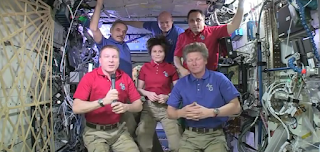Soyuz spaceship backs away from the International Space Station.
Crew changes at the ISS have been delayed due to the unexpected flaws in the Russian Soyuz 2 rocket program. After the failure of a Soyuz 2 rocket which caused the loss of a Progress resupply ship in May, the Soyuz spaceship launches were delayed a month giving investigators time to discover the problem. It was found that the disaster was likely caused by a failure to mate the progress ship to the Soyuz rocket correctly. Russia completed a successful Soyuz 2 rocket launch on June 5, paving the way to restart crew trips to and from the station.
Crew change ceremony. Expedition 43 commander Terry Virts,in red and holding microphone, passes command to Expedition 44 commander in blue, cosmonaut Gennady Padalka. Also returning home (in red shirts) were ESA astronaut Samantha Cristoforetti and cosmonaut Anton Shkaplerov.
Once the Change of Command Ceremony was completed, the 43 crew finished preparations for leaving the station and boarded their Soyuz TMA-15M spacecraft and began undocking procedures. The crew carefully moved away from the station to avoid firing thrusters in the direction of any of the sensitive station solar panels and antennas, when ground controllers noticed that some of the smaller thrusters had accidentally fired 48 times more than they were supposed to , causing the spacecraft to roll more than needed. According the NASAspaceflight.com, former Canadian astronaut Chris Hadfield told Twitter users that it was not unknown for that to happen, as the spacecraft has been sitting there for six months and it was possible to make a small mistake on the thrusters.
The crew floated in free-fall for a couple of hours before igniting the engines and slowing the spacecraft. The Soyuz headed for its fiery re-entry, and the crew separated the science and propulsion modules before hitting the atmosphere. Parachuting to the ground in the crew module, they touched down in Kazakhstan on Wednesday at 13:44 GMT.











